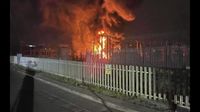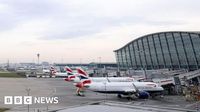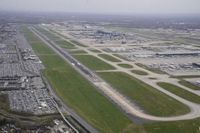A fire at an electrical substation near London’s Heathrow Airport led to the temporary shutdown of the airport on March 21, 2025, disrupting the travel plans of hundreds of thousands of passengers. The fire occurred at the North Hyde substation, about two miles from the airport, around 23:23 GMT the previous night. The London Fire Brigade responded quickly, deploying ten engines and approximately 70 firefighters, and managed to control the blaze by 06:28 on Friday morning.
The disruption affected at least 1,350 flights, as flight tracking services cited global ripple effects with cancelled and diverted trips across numerous airlines. Passengers who had already commenced their travels experienced long delays, with some being redirected to airports such as Gatwick in London, Charles de Gaulle in Paris, or Shannon in Ireland. Affected travelers, like Lawrence Hayes returning from New York, expressed frustration and exhaustion after being diverted to unexpected locations.
Heathrow Airport, known as Europe’s busiest flight hub and serving 83.9 million passengers in 2024, released a statement indicating uncertainty around the power restoration timeline. “We expect significant disruption over the coming days, and passengers should not travel to the airport under any circumstances until the airport reopens,” the airport advised, fundamentally altering the travel landscape for the time being.
The fire led to a power outage not only affecting the airport but also leaving more than 16,300 homes without electricity, as stated by Scottish and Southern Electricity Networks. Concerns have been raised regarding the airport's infrastructure resilience, particularly how a single fire could incapacitate a critical element of operations. Energy Secretary Ed Miliband mentioned that there was “no suggestion of foul play,” suggesting the possibility of a technical failure. Nevertheless, counterterrorism police are involved in the investigation to swiftly determine the circumstances surrounding the fire.
Experts have voiced alarm over the dependency of critical infrastructures like Heathrow on single power sources. Willie Walsh, Director General of the International Air Transport Association, emphasized, “How is it that critical infrastructure – of national and global importance – is totally dependent on a single power source without an alternative?” This incident has opened a broader dialogue about the need for improved planning to safeguard essential services against potential disasters, as echoed by Alan Mendoza from the Henry Jackson Society.
The fire itself emerged unexpectedly, with onlookers near the airport recalling a loud explosion followed by a fireball and dense clouds of smoke. Evacuations of residents living close to the power station were prompted, underscoring the blaze's intensity and immediate danger. Reports indicated that while firefighters worked diligently through the night, multiple power systems at the airport also experienced failures, significantly complicating the recovery efforts.
Despite the eventual control of the fire, the restart of normal airport operations poses a challenge, primarily due to the complex network needed to provide power efficiently. The scale of energy consumption at Heathrow rivals that of a small city, and complete rollback on services requires extensive checks and coordination across numerous systems. Passengers today are met with a rare silence; flights that typically depart every 90 seconds are halted, leaving residents who have grown accustomed to the airport's noise struck by unusual peace.
As investigations proceed, experts assert that lessons must be learned to avoid a future recurrence of this nature. The future of resilient transport infrastructure in the UK, especially in urban hubs like Heathrow, has never been more critical. For the present, inconvenienced travelers like Andrea Sri from London voiced disappointment at the chaos, expressing how their anticipated flight vanished in thin air and how difficult it has been to contact their airline for alternatives.
With Heathrow’s operational status still uncertain, budget airlines like Ryanair have stepped in with emergency service flights to manage the overflow of stranded travelers. However, broader implications for travel logistics continue as national rail services to and from the airport remain canceled, causing added stress to those attempting to navigate their travel plans.
The consequences of the fire at Heathrow Airport emphasize the delicate balance of modern-day travel and infrastructure reliability. The scale of the incident may potentially cause ripple effects across multiple sectors for days while officials strive to restore flight schedules and address the fallout from such an unprecedented disruption. As it stands, the looming question persists: How will lessons from this event reshape policies surrounding critical infrastructure in the future?




